
The Phasmatodea are an order of insects whose members are variously known as stick insects, stick-bugs, walkingsticks, stick animals, or bug sticks. They are also occasionally referred to as Devil's darning needles, although this name is shared by both dragonflies and crane flies. They can be generally referred to as phasmatodeans, phasmids, or ghost insects, with phasmids in the family Phylliidae called leaf insects, leaf-bugs, walking leaves, or bug leaves. The group's name is derived from the Ancient Greek φάσμα phasma, meaning an apparition or phantom, referring to their resemblance to vegetation while in fact being animals. Their natural camouflage makes them difficult for predators to detect; still, many species have one of several secondary lines of defense in the form of startle displays, spines or toxic secretions. Stick insects from the genera Phryganistria, Ctenomorpha, and Phobaeticus include the world's longest insects.

Extatosoma tiaratum, commonly known as the spiny leaf insect, the giant prickly stick insect, Macleay's spectre, or the Australian walking stick, is a large species of Australian stick insect. The species has the Phasmid Study Group number PSG9.
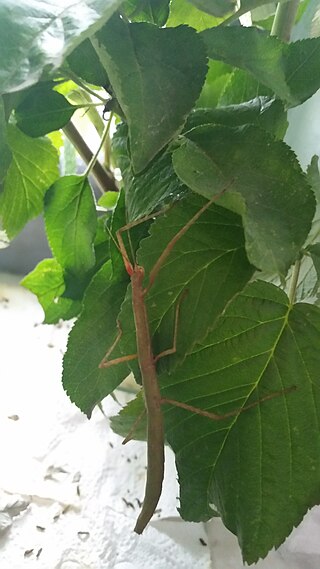
Carausius morosus is a species of Phasmatodea (phasmid) often kept as pets by schools and individuals. Culture stocks originate from a collection from Tamil Nadu, India. Like the majority of the Phasmatodea, C. morosus are nocturnal. Culture stocks are parthenogenetic females that can reproduce without mating. There are no reports of males, although in captivity, gynandromorphs are sometimes reared.

Heteropteryx is a monotypic genus of stick insects containing Heteropteryx dilatata as the only described species. and gives its name to the family of the Heteropterygidae. Their only species may be known as jungle nymph, Malaysian stick insect, Malaysian wood nymph, Malayan jungle nymph, or Malayan wood nymph and because of their size it is commonly kept in zoological institutions and private terrariums of insect lovers. It originates from the Malay Archipelago and is nocturnal.

Timema is a genus of relatively short-bodied, stout and wingless stick insects native to the far western United States, and the sole extant member of the family Timematidae. The genus was first described in 1895 by Samuel Hubbard Scudder, based on observations of the species Timema californicum.

Megacrania batesii, commonly known as the peppermint stick insect, is an unusual species of stick insect found in northeastern Australia, the Bismarck Archipelago, the Solomon Islands, New Guinea, and possibly as far north as the Philippines. It is notable for its aposematic coloration, as well as its robust chemical defense mechanism. Its common name refers to the irritating fluid — with an odor resembling peppermint — that it sprays as a defensive action from a pair of glands located at its prothorax when threatened, as well as the cylindrical, twig-like shape of its body. A member of the subfamily Megacraniinae, it was first described by English naturalist and explorer Henry Walter Bates in 1865.
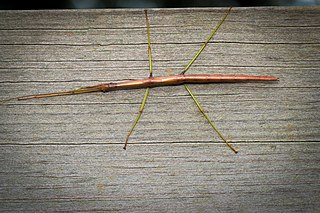
The common walkingstick or northern walkingstick is a species of phasmid or stick insect found across North America. The average length of this species is 75mm (3 in) for males and 95mm (3.7 in) for females.
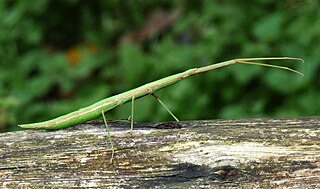
The European stick insect also called the European stick bug, European walking stick, or Mediterranean stick insect, is a species of stick insect, common in southern Europe. The species is endemic to the northwestern Mediterranean, especially Italy, Spain, Southern France, and the Balkans.

Medauroidea extradentata, commonly known as the Vietnamese or Annam walking stick, is a species of the family Phasmatidae. They originate in Vietnam and are found in tropical forests there. They eat a variety of foliage, though in captivity they commonly eat blackberry bramble, hawthorn, oak, red maple, and rose.

Peruphasma schultei, known as the black beauty stick insect and the golden-eyed stick insect, is a species of phasmid found in the Cordillera del Condor region of northern Peru. In the wild the insect feeds on Schinus plants, but will feed on privet, Aucuba japonica and honeysuckle in captivity. In Peru they are only known to exist in a region of less than 5 hectares, usually on volcanoes or mountains, but since their discovery they have become increasingly popular as pets worldwide due to their unusual colouration and they are now bred regularly in captivity.

Eurycnema goliath, commonly known as the goliath stick insect, or the regal stick insect, is a large species of stick insect in the family Phasmatidae, endemic to Australia and considered one of the largest species of stick insects in the country. The species has the Phasmid Study Group number PSG14.

Anchiale austrotessulata, the tessellated stick insect, tessellated phasmid or tessulata stick insect, is a medium-sized, stick insect found in the Brisbane area of Australia. Fully grown males in mating season exhibit frenetic behaviour. This species is also parthenogenetic.
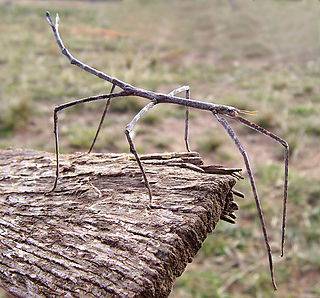
Ctenomorpha marginipennis, the margin-winged stick insect, is a species of stick insect endemic to southern Australia. The species was first described by George Robert Gray in 1833.

Pulchriphyllium bioculatum, Gray's leaf insect, is a leaf insect of the family Phylliidae native to tropical Asia as well as Madagascar, Mauritius and the Seychelles. It was first described by George Robert Gray in 1832 and was the first phasmid he discovered. Leaf insects have extremely flattened, irregularly shaped bodies, wings, and legs. They are usually about 5–10 cm long. They are called leaf insects because their large, leathery forewings have veins that look similar to the veins on the particular type of leaves they inhabit. Its scientific name bioculatum means "two-eyed" and refers to the two dots located on the abdomen just in this species.

Eurycantha calcarata is a species of phasmid endemic to Australasia.
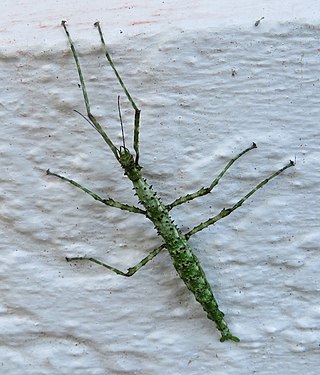
Acanthoxyla prasina, the prickly stick insect, is a stick insect in the order Phasmatodea and the family Phasmatidae. It is native throughout New Zealand, although it is less frequently reported than "common" stick insect species. It has been introduced to Britain, predominantly Cornwall and Devon, and to the south-west region of the Republic of Ireland. It has a thorny skin, which is used as camouflage.

Acanthoxyla inermis is an insect that was described by John Salmon in 1955. Acanthoxyla inermis is included in the genus Acanthoxyla, and family Phasmatidae. No subspecies are listed. This species is native to New Zealand but has been unintentionally moved to Great Britain where it has grown a stable population and is the longest insect observed in the UK, and the most common of the stick insects that have established themselves on the island.
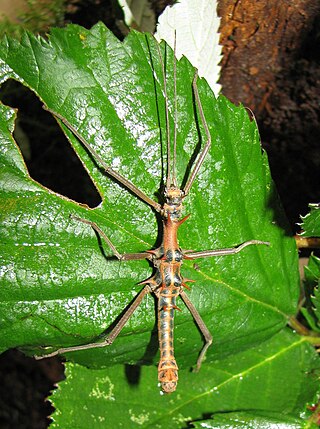
Epidares nolimetangere, the touch-me-not stick insect, is an insect species from the order of the Phasmatodea and the only representative of the genus Epidares. The species name nolimetangere comes from Latin and means "don't touch me". It refers to the prickly appearance of the animals.
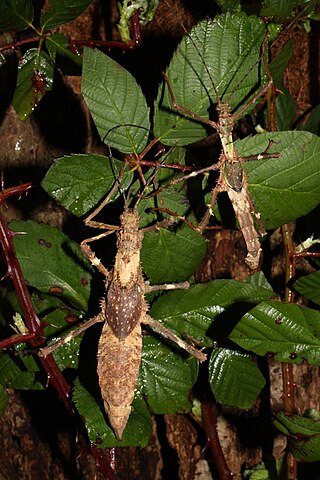
Haaniella is a genus of the Phasmatodea family Heteropterygidae from Southeast Asia.

Hoploclonia gecko is a relatively small, spiny and darkly colored stick insect species that is native to the northwest of Borneo.





















